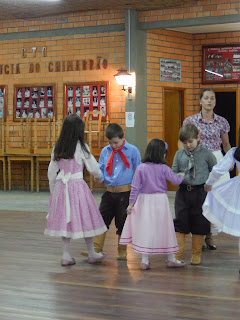Time stops for no one - including GSE - so after only 24 hours in Fraiburgo, it was time to say goodbye, load our luggage and board the bus, and head 2 hours west to Catanduvas. The city is a small town with only 10,000 inhabitants, but its economy is very diversified. There are 50 different industries in Catanduvas, with an emphasis on erva mate production and Brasil Foods (BRF).
 |
| Our Fraiburgo host families |
 |
| A full van... is there room for us? |
 |
| The center of Catanduvas (sort of like Atlanta's big chicken) |
After storing our (many!) bags, we all headed to the BRF factory, which produces poultry feed. There are 2 different duck feed products and 5 different chicken feed products, each specialized for a specific times in the bird's lifespan. BRF produces 2,500 tons/day, which is immediately transported out to the farmers contracted by BRF to grow and take care of the chickens and can store and additional 1,700 tons. The company is incredibly important to this region, as it provides transport, fuel, production, hotels, and other economic opportunities. Nearly 80% of the final product is exported outside the country.
Lunch was an early highlight of the day, as Sofie taught us how to make caipirinhas. Drinks for lunch? Yes, please!
 |
| Adding sugar to the mulled limes |
 |
| Taste test! |
Post-lunch, we presented the Catanduvas Rotary Club with our banners, and we were honored to learn this was the club's very first banner exchange! Rotary Catanduvas was founded last year, after the original club folded about 10 years ago. The average age of its 21 members is 33 which reflects the club's youth, and only 1 member was/is a member of both clubs.
 |
| Banner exchanges |
Continuing our poultry education, we then went to a chicken farm which is contracted by BRF for egg production We saw eggs being prepared for incubation, and then moved to the coops. There are 20 hens/house and 1 rooster for about 10 hens. The roosters are placed 5 days before the hens are introduced, which allows them to mark their territory; interestlying, if a hen doesn't take to a rooster, they will switch that rooster (rather then the hen) to a different part of the coop.
Our BRF lessons complete, we moved on to the erva mate. Catanduvas is the center of erva mate for Santa Catarina, and we visited Erva Mate Catanduvas, one of the best producers in the city. The business was established 30 years ago with plants that naturally grew in the area; now, the business is 100% organic with no pesticides. The workers are paid $0.20 for each beetle they catch by hand, which cuts down on their destruction. The other predator to the erva mate leaf is worms, which burrow into the tree and destroy the plant. The company solves this by feeding the birds who naturally prey on these worms (Curucaca), thereby keeping them close to eat the worms before they can burrow. The sustainability is incredible; in addition to feeding the birds, they also have about 20+ castrated bulls who roam and maintain the property, and 3 chicken houses which they use for manure to fertilize the plants. This holistic and self-sufficient structure is representative of a number of companies we've seen over the last 3 weeks.
 |
| Worm holes burrowed into one of the erva mate trees |
 |
| The curucaca bird, with its long beak ideal for digging worms out of trees |
 |
| Walking through the erva mate fields |
 |
| Erva mate products ready for sale |
From tea to ainto o orphanage... the Catanduvas Rotary Club has supported a small patronage, and we visited the 10 children who are currently living there (capacity is 12). The kids range in age from 6 months to 17 years old, including 5 brothers. The space was small, but well taken care of, as each child is responsible for making their bed and straightening their wardrobe/shelf area. We really enjoyed having the kids show us around their house, show off with backflips, and be super generous with their hugs and smiles. We'll remember this for a very long time.
Finally, we went to Recanto da Tradicao, which is a cultural center for the gaucho traditions. The retail store sold traditional gaucho attire, music, and other accessories, and after a brief introduction, we then watched local children perform the traditional gaucho dances. There were three different levels of students who performed, and they were all beautiful. While we were there to see them, they wanted to see us, and the group was swarmed by about 20 kids after their performances ended. It was so much fun to hear them practice their English with us, listen to their laughter at hearing us speak Portuguese and take pictures with everyone as Nora was hustling us out the door. :)
 |
| Do we look authentic? |
 |
| Emily, surrounded by the dancers |
 |
| Some of the kids |
Sadly, it was then time to go, and we were driven about an hour to Xanxere by Sofie, Ricardo, and Roberto (the club president) where we met the next club. I know I speak for all of us when I say little Catanduvas has left a big impression on our corazao <3

















Very nice having you guys, you're also in our corazao hehe
ReplyDeleteTruth is we are all more alike than we are different and that hugs and smiles go a long way toward understanding!
ReplyDelete